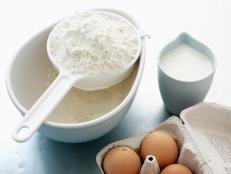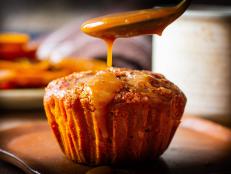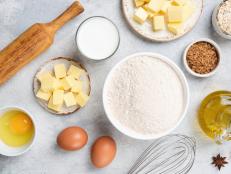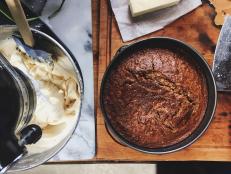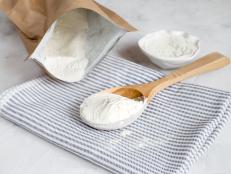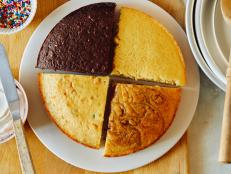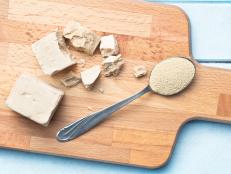What's the Difference Between Glass and Metal Baking Pans?
You’ll want to read this before making your next batch of brownies.

ahirao_photo/Getty Images
By Jessie Sheehan for Food Network Kitchen
Jessie Sheehan is a baker and cookbook author.
Glass and metal baking pans could not behave more differently than one another when heated. Metal heats up fast and cools down quickly. Glass heats up slowly and cools down slowly. And these differences are not only fascinating (yes, we Food Network nerds dig getting into the minutiae of baking pan materials) but also, they are super useful in helping to determine when you should choose one kind of pan versus the other. Like, should you bake a chocolate cake in a glass Pyrex? Should you bake a pie in a metal pan? Are brownies best in glass? In metal? What about a berry crisp? Lucky for you, we address ALL these queries and more, below.
What Are the Characteristics of a Metal Baking Pan?
- Heats up quickly and cools quickly: A metal baking pan heats up quickly in a hot oven, as metal is an excellent conductor of heat.
- Bakes more slowly than glass: Interestingly enough, however, metal pans bake things more slowly than glass pans do. Because of this, if a recipe calls for a glass pan and you decide to use a metal pan instead, be sure to add a few minutes to the baking time.
- Can adversely react with acidic ingredients: Some metal pans negatively react with acidic ingredients. So, when making something fruity or citrusy, like a cobbler or a baked lemon pudding situation, you should stick to a glass pan.
- The darkness of the metal matters: You might notice that some recipes specify light or dark metal baking pans. That’s because the color makes a difference: a dark colored metal pan will absorb more heat than a light-colored one.
- Creates sharp edges and corners: As for the aesthetics of baking in metal, a metal pan provides your cakes and brownies with the sharpest of edges and corners, and for some of us (okay, ALL of us) that is preferable to the soft, round corners that a glass pan creates.
What Are the Characteristics of a Glass Baking Pan?
- Retains heat better than metal: A glass pan is pricier and heavier than a metal one and retains heat better (which is why a metal pan cools quickly on the counter and a glass one does not) and is great for keeping a dessert warm at the table, like a hot fudge pudding cake.
- Bakes more quickly than metal: If you need to substitute a glass pan for a metal one, you will need to decrease the oven temperature by about 25 degrees to ensure that your baked good does not bake too quickly and burn.
- Is nonreactive with acid: Glass, unlike metal, is nonreactive, so is a perfect vessel when baking with berries or citrus.
Is a Glass or Metal Pan Better for Baking?
At the risk of alienating the glass lovers in the house, we think metal is better when it comes to baking. Here’s why. Sweets bake and brown more evenly in metal pans; in glass pans, the outside of the baked good is usually done before the inside. Additionally, metal pans create sharp, aesthetically pleasing edges on baked goods, while glass pans create rounded edges.
Cooking is a different story, however: we love a mac-n-cheese, lasagna, baked ziti or really any casserole in a glass pan. The glass bottom and walls show off their pretty layers and keep the dishes warmer longer than a metal pan would. So, glass definitely has its place, just not when we’re prepping for the school bake sale.
What Should I Bake In a Metal Baking Pan?
We hate to say it – we’ve got nothing against glass, we promise! – but metal does an overall better job than glass of baking almost everything except for acidic desserts. It bakes evenly because it heats up so quickly. It also browns beautifully and crisps to perfection.
- Cookies
- Bars
- Brownies
- Cakes
- Bread
- And more!
What Should I Bake In a Glass Baking Pan?
There are a few times when glass pans are better for baking.
- Pies. If you’re a beginner, you can literally lift up the pie plate (with pot holder’ed hands!) and look at the bottom of the crust to see when it is ready to be pulled from the oven – and we love glass for that.
- Anything acidic. Think: berry crisps! Glass won’t react with acidic ingredients, while metal might.
- Baked French toast casserole and bread pudding. The glass keeps these dishes warmer longer than metal would and shows off their pretty layers.
Recipes Calling for Glass and Metal Pans
Want to see glass and metal pans in action? Check out some of the different recipes that call for each – and then make them all.
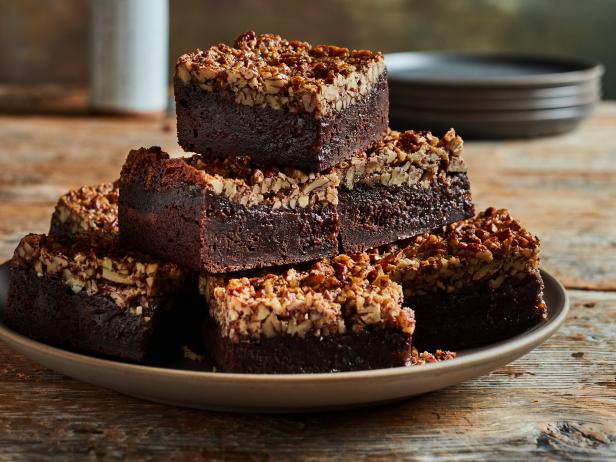
Matt Armendariz
Although the recipe doesn’t specify the type of 9-inch baking pan, we recommend a metal pan, as opposed to glass, as a brownie is not a brownie without the sharp edges and corners that only a metal plan can deliver – are we right?

Here the recipe calls for an 8-inch square flame proof baking dish, and we’re pretty sure that’s code for glass (or ceramic). A glass pan is great when baking up an eggy casserole type treat, like this croissants bread pudding.

The recipe for these “fan favorite” chocolate chip cookies might not specify the material of the baking sheets on which you bake these cuties, but we think it’s fair to say they’re metal. Lightly browned, crispy-edged and soft-middled chocolate chippers wouldn’t have it any other way.
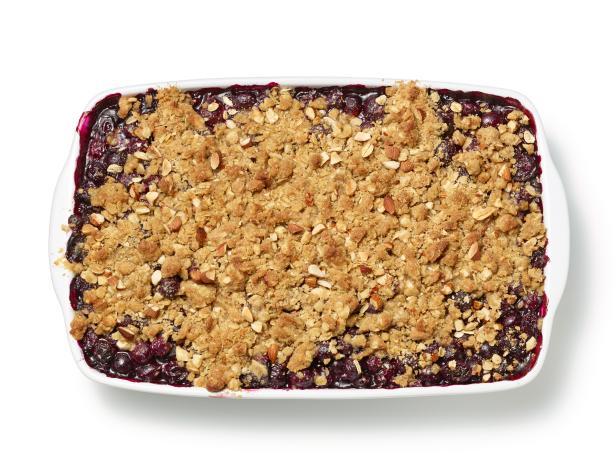
Kang Kim
This crisp is baked in a 2-quart baking dish, which could easily be made of glass (or ceramic - both will work). Glass is nonreactive and is thus a perfect vessel for baking up the berries, sprinkled with lemon juice, in this crisp.
Related Links:
























